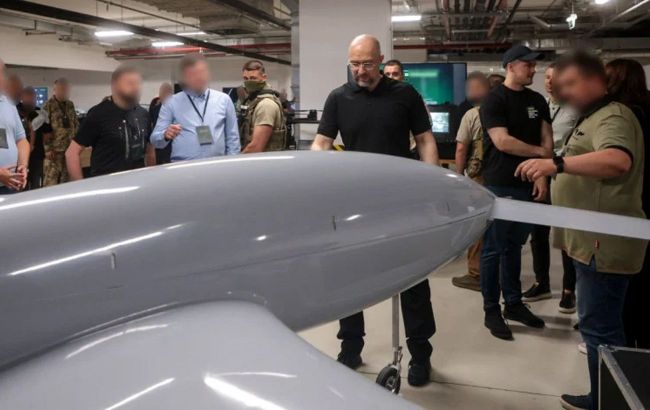Bober, Liutyi, and Valkiriya: How Ukrainian UAVs eliminate enemy on front lines and in rear
 Prime Minister of Ukraine Denys Shmyhal near the Ukrainian drone (photo: Ukrainian world congress)
Prime Minister of Ukraine Denys Shmyhal near the Ukrainian drone (photo: Ukrainian world congress)
The war of Ukraine against Russian invaders is often referred to as a technology war, as combat actions are conducted in conditions of constantly evolving military technology. One of the technologies that has quickly gained a critically important position on the front lines is drones. They assist in reconnaissance, neutralizing the enemy from a distance, and reaching deep into the enemy's rear. Ukrainian drones are regularly used by intelligence services to target Russian military objects.
Today, Ukraine is one of the most powerful drone producers. Which Ukrainian drones are considered to be among the best for combat - in the material of RBC-Ukraine.
Bober (Beaver): Scourge of Russian oil refineries
UJ-26 Bober is a long-range kamikaze drone produced by the Ukrainian company UkrJet. It is analogous to the Iranian Shahed-131. The drone is built with a duck-type aerodynamic system, allowing it to maneuver better in the air and increasing its chances of avoiding air defense systems while changing targets without loss of lift. The unmanned aerial vehicle has an internal combustion engine.
The drone's range is approximately 800 km, with a cost of 4 million hryvnias.
The first photo of the drone was published by blogger Ihor Lachenkov in May 2023. The drone has evolved, and in the initial stages of production, it was conceived as something different, notes Taras Chmut, director of the Return Alive foundation.

Bober (Beaver) (photo: website of the Cabinet of Ministers of Ukraine)
"We went from one product to the grandfather Bober, and then evolved to Bober. So, we have our own school, so to speak, it's roughly speaking. That is, our own production. It's not an artificial product, in the sense that they don't make five or ten of them a month. It's mass production, it can be scaled up," said Taras Chmut.
Today, the Bober is actively used for strikes against the enemy's rear. For example, according to Russian official sources themselves, the Bober struck Moscow and the Moscow region, damaged oil refineries in the Krasnodar region, in Tuapse. According to representatives of the Return Alive foundation, the UAV also struck a plant that manufactures electronics for the Kh-31, Kh-35, and Kh-59 missiles. Additionally, the Bober hit a warehouse where missile components for the Iskander were stored.
Liutyi (Fierce): Drone for deep rear operations
Liutyi became well-known after a series of attacks on the Russian rear, primarily targeting oil refineries. The development of this drone was first announced in October 2022 by Ukroboronprom. They announced their intention to create a UAV weighing over 200 kg, capable of delivering a 75 kg projectile over a distance of more than a thousand kilometers. For the first time, during a public demonstration, Ukroboronprom showcased part of the drone's fuselage with the inscription "I will repay." In November, they announced the first tests of Liutyi.

Liutyi (Fierce) (photo: Facebook)
Liutyi is also an analog of the Iranian Shahed - this was announced by Minister of Strategic Industries Oleksandr Kamyshyn on January 16, 2023. The drone's fuselage is designed in the form of a twin-beam low-wing aircraft. The internal combustion engine is located in the aft section. The UAV has a wheeled chassis and relatively small dimensions, allowing it to launch without being tied to airfields.
The wingspan of Liutyi is 6.7 m, length 4.4 m, and takeoff weight 250-300 kg.
Since the beginning of 2024,Liutyi has successfully attacked a number of targets in Russia. This includes nine oil refineries, the Novolipetsk Metallurgical Combine, and the Nizhny Novgorod plant producing explosives. On March 20, Liutyi attacked the Engels airbase.
Valkiriya (Valkyrie): Eyes of aerial reconnaissance
Valkiriya is a Ukrainian drone designed for monitoring, reconnaissance, video surveillance, and artillery fire adjustment, manufactured by LLC Aviation Systems of Ukraine.
It was first handed over to the Armed Forces of Ukraine and the National Guard as volunteer aid in 2015. It underwent testing in 2017 and was cleared for operation. The cost of one complex is 800 thousand hryvnias. It includes two drones, day and night payloads, a ground control station, antennas, and additional equipment. The operational radius is up to 34 km, flight time is about 120 minutes, and cruising speed is 60 km per hour.

Ukrainian military with the Valkiriya (Valkyrie) drone in the Donetsk region (photo: Getty Images)
This drone, as noted by the military, has already proven itself on the front lines as a simple and reliable reconnaissance UAV.
"Among the major advantages of the UAV are its low radar signature, flight range, and rapid deployment, which, along with pre-flight preparation, can take just 5 minutes," added the Defense Forces.
Valkiriya can perform both 24/7 surveillance of the frontline and conduct reconnaissance up to 40 km deep.
What's being said about drones at the Ministry of Digital Transformation
The Ministry of Digital Transformation has become one of the main proponents of drone production in Ukraine. Over the course of two years of war, Ukrainian manufacturers have achieved significant success and literally launched UAV production from scratch. Today, manufacturing companies in Ukraine can produce up to 150,000 units per month. And the capacities continue to grow, noted Oleksandr Bornyakov, the Deputy Minister of Digital Transformation for IT Development.
"UAV production in Ukraine is expanding and scaling up every day because drones are effective and fast. Creating a tank takes several months and several million dollars. As for assembling a kamikaze drone, which will destroy or damage this tank, it takes only a few days, and the cost is measured in tens of thousands of hryvnias," Bornyakov commented to RBC-Ukraine.
According to him, defense technologies in Ukraine will be scaled up.
"Victory on the modern battlefield is impossible without innovation, so there will be more drones and other defense technologies in Ukraine," added Bornyakov.
According to RBC-Ukraine sources, on the evening of May 11, UAVs from the Main Intelligence Directorate attacked an oil refinery in Volgograd. This refinery belongs to the company Lukoil.
During the night of May 12, Main Intelligence Directorate attacked three military targets on the territory of Russia.

